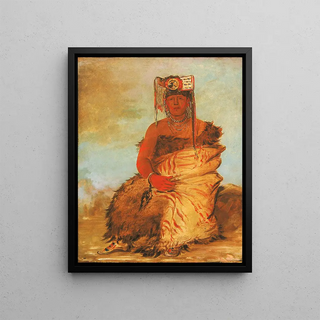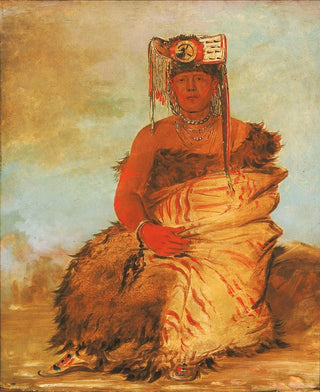Painting Laketoowirsha Little Chief, a Pawnee warrior from Tapage - George Catlin


View from behind

Frame (optional)
In the rich and captivating universe of art history, certain works stand out for their ability to capture the essence of a culture and a specific moment. The art print Laketoowirsha Little Chief, a Pawnee warrior from Tapage - George Catlin, is a perfect example, highlighting not only the aesthetic beauty of the painting but also the depth of the stories it conveys. This piece, created in the 19th century, transports us to a world where Native American traditions are celebrated with rare intensity and authenticity. Through the gaze of the Pawnee warrior, Catlin invites us to explore the values, struggles, and dignity of a often misunderstood people.
Style and uniqueness of the work
George Catlin's style is characterized by striking realism, masterful use of vivid colors, and meticulous attention to detail. In this art print, the Laketoowirsha warrior is depicted with a proud posture and an expression that evokes both strength and serenity. The traditional ornaments adorning his body, as well as the background evoking the American landscape, testify to an in-depth knowledge of Pawnee customs and symbols. Catlin does not merely paint a portrait; he tells a story, that of a people in harmony with nature, but also subject to the upheavals of their time. Every brushstroke seems to vibrate with a lively energy, and the viewer is invited to feel this deep connection between man and his environment.
The artist and his influence
George Catlin, painter and writer, dedicated a significant part of his career to documenting the indigenous peoples of North America. His commitment to preserving their culture and way of life is palpable in each of his works. Traveling across the United States, he had the opportunity to meet many chiefs and warriors, including Laketoowirsha, whose essence he captured with rare sensitivity. Catlin is often regarded as a pioneer of visual anthropology, as his works are not limited to aesthetics; they are also a valuable source of information.

Matte finish

View from behind

Frame (optional)
In the rich and captivating universe of art history, certain works stand out for their ability to capture the essence of a culture and a specific moment. The art print Laketoowirsha Little Chief, a Pawnee warrior from Tapage - George Catlin, is a perfect example, highlighting not only the aesthetic beauty of the painting but also the depth of the stories it conveys. This piece, created in the 19th century, transports us to a world where Native American traditions are celebrated with rare intensity and authenticity. Through the gaze of the Pawnee warrior, Catlin invites us to explore the values, struggles, and dignity of a often misunderstood people.
Style and uniqueness of the work
George Catlin's style is characterized by striking realism, masterful use of vivid colors, and meticulous attention to detail. In this art print, the Laketoowirsha warrior is depicted with a proud posture and an expression that evokes both strength and serenity. The traditional ornaments adorning his body, as well as the background evoking the American landscape, testify to an in-depth knowledge of Pawnee customs and symbols. Catlin does not merely paint a portrait; he tells a story, that of a people in harmony with nature, but also subject to the upheavals of their time. Every brushstroke seems to vibrate with a lively energy, and the viewer is invited to feel this deep connection between man and his environment.
The artist and his influence
George Catlin, painter and writer, dedicated a significant part of his career to documenting the indigenous peoples of North America. His commitment to preserving their culture and way of life is palpable in each of his works. Traveling across the United States, he had the opportunity to meet many chiefs and warriors, including Laketoowirsha, whose essence he captured with rare sensitivity. Catlin is often regarded as a pioneer of visual anthropology, as his works are not limited to aesthetics; they are also a valuable source of information.






